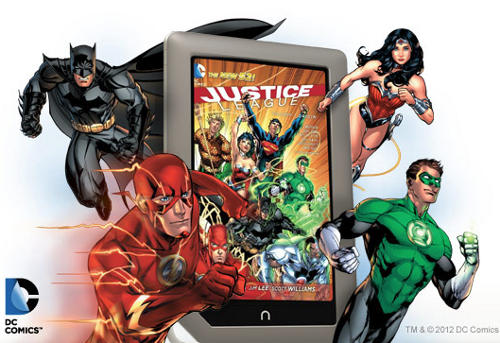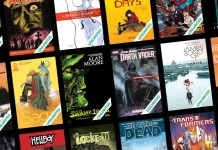by Bruce Lidl
With Thanksgiving (and the various themed shopping days that follow) now past us, the highpoint (or lowpoint depending on your viewpoint) of the annual shopping season has arrived in full force, and according to various trend observers, tablets are once again one of, if not the, thing to give or receive this year. Unlike in previous years however, when “tablet” actually just meant “iPad,” in 2012 we are finally seeing a bit of diversity in the “portable device that is bigger than a smartphone but doesn’t have a keyboard” category, beyond just the offerings from Cupertino. And considering what a great fit for comics tablets are proving to be, no matter the specific shape or size, not to mention the ever expanding offerings of digital comics, it is worth a glance to see how the landscape is shaping up for tablets and comics this year.
Amazon released the original Kindle Fire roughly a year ago, and while it has certainly not overtaken the tablet crown from the iPad, it did demonstrate that other companies could compete in the arena, particularly if their device had tight integration into broad content eco-systems (something that all the pre-Fire Android tablets sorely lacked). Smaller, less powerful, but decidedly cheaper, the Kindle Fire expanded the Kindle brand beyond mere black and white eReaders and helped to legitimize the 7 inch form factor, despite Steve Jobs’ previous dismissals of that format. Attempting to build on the first Kindle Fire’s success, Amazon has diversified its lineup of tablets this year, offering not just the original Kindle Fire ($159), but expanding with the Kindle Fire HD (same size and shape as original but better a 1280×800 screen, more powerful, etc for $199) and the Kindle Fire HD “8.9 (larger, better 1920×1200 screen, more powerful, etc. for $299).
Barnes & Noble technically beat Amazon to the punch with their Nook Color, a 7 inch Android skinned tablet very similar to the original Kindle Fire, but without the marketing power of Amazon, the Nook Color languished a bit compared to its Kindle competitor. Nonetheless, B&N (with some financial assistance from Microsoft) is pushing ahead with tablets, and now has an improved Nook HD (better screen, more powerful, etc. for $199) and a larger 9 inch Nook HD+ ($269). A third entry in the eReader-based Android-skinned tablet competition is the Canada-based Kobo, with a very Kindle Fire-like Kobo Vox ($179) and a newer Kobo Arc (better screen, more powerful, etc. $249).
The offerings from Amazon, B&N and Kobo share some fundamentals, notably they are essentially modified Android tablets, with strong integration with their respective online retailers. All of them do, however, allow the installation of Android apps so with some basic technical know-how they can each provide access to each other’s stores, or other independent markets. An owner of a Nook HD could conceivably purchase content from B&N, Amazon or any of the comics publishers affiliated with Comixology, iVerse or their own stores (like Dark Horse). Hence, preferences between these pretty similar devices will likely depend more on comfort with a particular retailer than any noticeable specification or app differences at a particular price point.
Of course, the hitherto dominant figure in the tablet world remains the iPad, and Apple continues to iterate the device now in its fourth generation. The big news is, however, the introduction of the iPad mini, the first major deviation from the original iPad format, shrinking the screen down from 9.7 inches to 7.85, creating a tablet that is smaller, lighter and more ergonomic, if sacrificing some power and display resolution. By all indications the iPad mini is proving to be very popular, and has even convinced some Apple observers that the mini is the logical development of the iPad, and the smaller format will become the “default” size ultimately. On the other hand, the mini goes backwards from a resolution standpoint (1024 x 768) and is not a “retina” display, or even “high definition” by normal understanding. While the mini obviously benefits from the maturity and depth of the overall iOS experience and App Store, from a specific comic perspective, the advantage the standard iPads have had in displaying graphic storytelling is somewhat blunted in this case. For $199 the Amazon Kindle HD has a 7 inch display with a resolution of 1280×800, and while resolution is not the only factor when it comes to screen quality, it does create an interesting comparison to the $349 iPad mini. The fourth generation non-mini iPad retains the larger screen size and high resolution display (2,048 × 1,536) of its predecessor, but did receive a computing power boost and starts at $499.
From a sheer visual quality standpoint, it is hard to beat reading comics on the larger, sharper iPad, but as we have already seen, Android competitors are not sitting still when it comes to resolution, and comics should look fantastic on any of the HD capable models from Amazon or B&N. The most buzzed about Android tablet this year, however, remains the Nexus 7, the first tablet in Google’s Nexus line of quasi-flagship devices that receive special software attention from Google. A relatively powerful device for its 7 inch screen size, with HD resolution, no retailer app restrictions and a guarantee of always receiving the latest version of the Android operating system, the Nexus 7 will appeal most to price sensitive power users at $199. There is also a larger Nexus 10 available, but with a size, screen and price ($399) that borders on iPad territory it is not as compelling an option, although digital comics will certainly look great on it.
Surprisingly, at least to me, what may be the best current “over-all” tablet choice with a comics emphasis is the Barnes&Noble Nook HD+. It has a large-ish size screen that displays digital comics excellently, has a pretty good price to performance ratio ($269 for the 16GB model), can be rooted for maximum flexibility and compatibility, and even has the ability to expand storage with microSD cards (up to 32GB added). Still small and light enough to be read in bed comfortably, the Nook HD+ offers many of the benefits of the larger iPad, but at almost half the price.









RT @Comixace: Digital Update: The New Tablet Scene for Comics: by Bruce Lidl With Thanksgiving (and the various themed… http://t.co/8 …
One advantage of the Nook over the Kindle is that B&N is less prone to censorship than Amazon. Granted, the audience for the kinds of books that Amazon refuses to sell on the Kindle (certain kinky erotica) is pretty small – that’s why they don’t hesitate to do it – but it’s an important principle.
Comics, both old and new, look incredible on my ipad3 with the retina display. Perfect screen size to display an entire page too and you can turn it horizontal for splash pages. Everything scales great.
I would not recommend tablets with smaller screens than the standard ipad size for comics. And anyone trying to get a decent comic reading experience out of their phone is, in my opinion, simply wasting their time and probably their eyesight as well.
RT @Comixace: Digital Update: The New Tablet Scene for Comics: by Bruce Lidl With Thanksgiving (and the various themed… http://t.co/8 …
No mention of the Microsoft Surface?
@Glenn Simpson
I thought about including the Surface in the post, but felt it was a bit far afield. Plus, unlike the others, I haven’t spent much time with a Surface yet to really get a sense of it. Have you tried one out for comics reading?
Nope, that’s why I was hoping you had :)
I’ve played with Windows 8 a bit. And I believe it has the 10ish inch screen for which I have a preference…
I started with the B&N Nook eReaders, but when my wife got me a Nook Tablet I returned it for a Kindle Fire. B&N just never seemed to get it in gear on content, and they blocked side loading apps right when I wanted to try Comixology on it. The Kindle Fire lets you install just about any Android app you want (for instance, I run the Nook app on it), and you can skin the OS without rooting. Plus Amazon has great content, all the perks that come with Prime membership, and a record of openness (selling DRM-free music in a non-proprietary format). My wife has an iPad, but I don’t like how Apple is continually trying to shackle it’s device users to Apple content. Besides, technology is essentially disposable, so overpaying for it is a luxury I can’t afford. I only keep a phone for two years. I don’t need it to be aluminum.
I’ve been dabbling in reading digital comics on my Nexus 7, mainly through ComiXology. The screen is big enough that most pages look good. Lettering size for most print-designed comics is just this side of readable for me. That’s not a problem now while my eyes are still good, but in the future I expect it may be.
The main problem I have is actually with ComiXology’s in-app store. It’s really inconvenient to locate titles I’ve purchased but haven’t downloaded.
If I wanted a dedicated comics reader, I’d probably pick up a 10 inch tablet, but for a general device, I like the 7-inch form factor a lot.
I own both an iPad3 and an older Toshiba Thrive which is a 10.1″ Android tablet. Despite the iPad3 having a higher resolution, I enjoy reading digital comics much better on the Thrive. The wide screen 10.1″ means it fits a full size comic book page quite nicely. The iPad 9.8″ at a 4:3 aspect ratio means it’s a lot shorter than the 10.1 Android tablets and you end up with bars on the sides because the page doesn’t fit properly. So despite the lower resolution, I like it being closer to a physical comic book page. The Nexus 10 looks great, but I own enough tablets right now (my wife also has the Nexus 7) and will likely wait longer before I replace the Thrive.
Also speaking of the Nexus 7, the latest Android update version 4.2 is great for families with it’s multi-user login. Basically you can add a user and then when the device starts up or wakes up there are avatars and names on the bottom of the screen which the user can switch to the right person and log in.
So a kid can then pick an Android 4.2 tablet and log into Comixology and see their comics (say Bone) without stumbling onto their dad’s Sin City Comics.
I’ve had the original Kindle Fire since it came out, and I’ve purchased a good deal of comics for the ComiXology app there. In terms of screen size, the iPad wins, because the Fire isn’t very adequate at reading page by page (the panel view works out better for tablets smaller than an iPad). But generally, I don’t want to be reading on an iPad/10-inch tablet for long amounts of time — it’s not comfortable to hold those things after an issue or so. Thanks for the tablet coverage.
I’m currently able to get my comics cheaper on paper, but I had resigned myself that if that ever changed, I would switch to digital. However, I was slightly put off the other day when I was reading some free digital comics on my laptop, and realized that the screen size on my laptop (which is a little bigger than average), while landscape, was displaying the comics in portrait at about 10″ from corner to corner. And while it certainly was readable, I found the word balloons to be a little small for my eyes. Maybe in addition to panelview, the adaptations could increase the size of the text a bit for those who want to do full page but need a little help on the balloons?
Comments are closed.